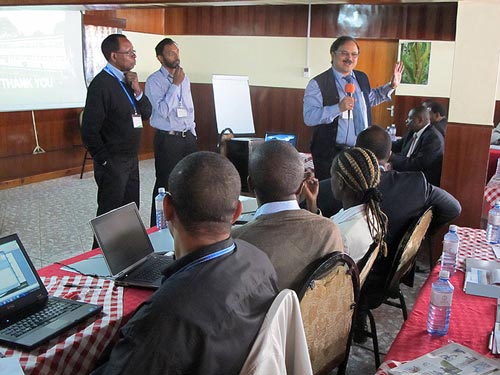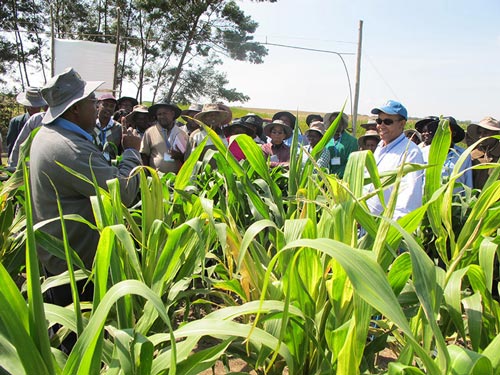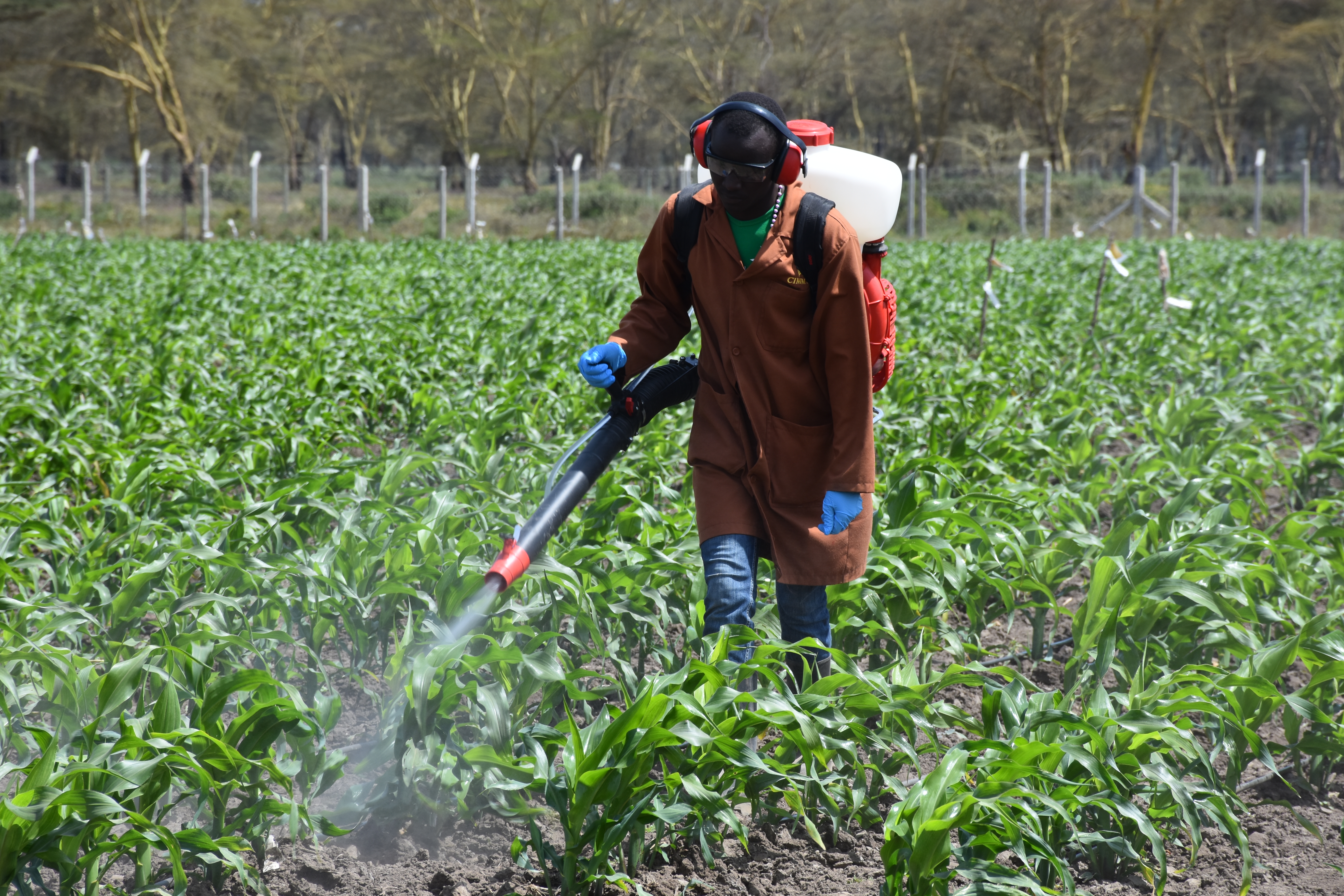 “I can now identify with accuracy plants affected with maize lethal necrotic disease,” stated Regina Tende, PhD student attached to CIMMYT, after attending the CIMMYT-Kenya Agricultural Research Institute (KARI) “Identification and Management of Maize Lethal Necrosis” workshop in Narok, Kenya, during 30 June-3 July 2013. This was not the case a few weeks ago when Tende, who is also a senior research officer at KARI-Katumani, received leaf samples from a farmer for maize lethal necrosis (MLN) verification.
“I can now identify with accuracy plants affected with maize lethal necrotic disease,” stated Regina Tende, PhD student attached to CIMMYT, after attending the CIMMYT-Kenya Agricultural Research Institute (KARI) “Identification and Management of Maize Lethal Necrosis” workshop in Narok, Kenya, during 30 June-3 July 2013. This was not the case a few weeks ago when Tende, who is also a senior research officer at KARI-Katumani, received leaf samples from a farmer for maize lethal necrosis (MLN) verification.
Tende is one of many scientists and technicians who experienced difficulty in differentiating MLN from other diseases or abiotic stresses with similar symptoms. According to Stephen Mugo, CIMMYT Global Maize Program (GMP) principal scientist and organizer of the workshop, this difficulty encouraged CIMMYT and KARI to organize this event to raise awareness about MLN among scientists, technicians, and skilled field staff; provide training on MLN diagnosis especially at field nurseries, trials, and seed production fields; train on MLN severity scoring to improve the quality of data generation in screening trials; and introduce MLN management in field screening sites to scientists, technicians, and skilled staff. The workshop brought together over 80 scientists and technicians from CIMMYT, KARI, and other national agricultural research systems (NARS) partners from Tanzania, Uganda, Rwanda, and Zimbabwe.
“It is important that all the people on the ground, particularly the technicians who interact daily with the plants and supervise research activities at the stations, understand the disease, are able to systematically scout for it, and have the ability to spot it out from similar symptomatic diseases and conditions like nutrient deficiency,” stated GMP director B.M. Prasanna.
Proper and timely identification of the MLN disease, which is a pre-requisite for effective control, is not easy. CIMMYT maize breeder Biswanath Das explains: “First of all, the disease is caused by a combination of two viruses, Maize chlorotic mottle virus (MCMV) and Sugarcane mosaic virus (SCMV). Secondly, its symptoms –severe mottling of leaves, dead heart, stunted growth (shortened internode distance), leaf necrosis, sterility, poor seed set, shriveled seeds– are not always unique to MLN but could be due to other fungal diseases and abiotic conditions.” The training workshop was one of CIMMYT/KARI initiatives to combat the disease threatening all the gains made so far in maize breeding. “With nearly 99% of the commercial maize varieties so far released in Kenya being susceptible to MLN, it is important that institutions like CIMMYT and KARI, in strong collaboration with the seed sector, develop and deploy MLN disease resistant varieties in an accelerated manner,” stated Prasanna. One of the key initiatives in this fight is the establishment of a centralized MLN screening facility under artificial inoculation for Eastern Africa at the KARI Livestock Research Farm in Naivasha. Plans are also underway to establish a network of MLN testing sites (under natural disease pressure) in the region to evaluate promising materials from artificial inoculation trials in Naivasha. The state of the art maize doubled haploid (DH) facility currently under construction in Kiboko will also play a crucial role in accelerating MLN resistant germplasm development. “The DH technology, in combination with molecular markers, can help reduce by half the time taken for developing MLN resistant versions of existing elite susceptible lines,” stated Prasanna.
 During his opening speech, Joseph Ng’etich, deputy director of Crop Protection, Ministry of Agriculture, noted that about 26,000 hectares of maize in Kenya were affected in 2012, resulting in an estimated loss of 56,730 tons, valued at approximately US$ 23.5 million. Seed producers also lost significant acreages of pre-basic seed in 2012: Agriseed lost 10 acres in Narok; Kenya Seed lost 75; and Monsanto 20 at Migtyo farm in Baringo, according to Dickson Ligeyo, KARI senior research officer and head of Maize Working Group in Kenya.
During his opening speech, Joseph Ng’etich, deputy director of Crop Protection, Ministry of Agriculture, noted that about 26,000 hectares of maize in Kenya were affected in 2012, resulting in an estimated loss of 56,730 tons, valued at approximately US$ 23.5 million. Seed producers also lost significant acreages of pre-basic seed in 2012: Agriseed lost 10 acres in Narok; Kenya Seed lost 75; and Monsanto 20 at Migtyo farm in Baringo, according to Dickson Ligeyo, KARI senior research officer and head of Maize Working Group in Kenya.
While this loss represents only 1.7%, Ligeyo assured everyone that Kenya is not taking any chances and has come up with a raft of measures and recommendations: farmers in areas where rainfall is all year round or maize is produced under irrigation are advised to plant maize only once a year; local quarantine has been enforced and farmers are to remove all infected materials from the fields and stop all movement of green maize from affected to non-affected areas; seed companies must ensure that seeds are treated with appropriate seed dressers at recommended rates, they must also promote good agricultural practices, crop diversification, and rotation with non-cereal crops.
Throughout the workshop, participants learned about theoretical aspects of MLN, such as the disease dynamics, management of MLN trials and nurseries, and identification of germplasm for resistance to MLN. They also participated in practical sessions on artificial inoculation, and identification and scoring. Several CIMMYT scientists played an active role in organizing the workshop, including breeders Stephen Mugo, Biswanath Das, Yoseph Beyene, and Lewis Machida; entomologist Tadele Tefera; and seed systems specialist Mosisa Regasa. They were accompanied by KARI scientist Bramwel Wanjala, KEPHIS regulatory officer Florence Munguti, and NARS maize research leaders Claver Ngaboyisonga (Rwanda), Dickson Ligeyo (Kenya), Julius Serumaga (Uganda), and Kheri Kitenge (Tanzania). During his closing remarks, KARI Food Crops program officer Raphael Ngigi, on behalf of KARI director, urged participants to rigorously implement what they had learnt during the workshop in their respective countries or Kenya regions to help combat MLN at both research farms and farmers’ fields.
Commenting on the usefulness of the workshop, technical officer at KARI-Embu Fred Manyara stated: “I will no longer say I do not know or I am not sure, when confronted by a farmer’s question on MLN.”
 Capacity development
Capacity development 